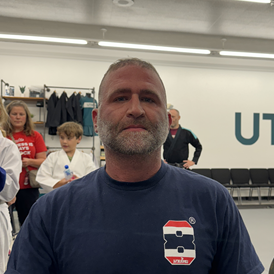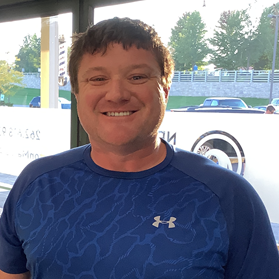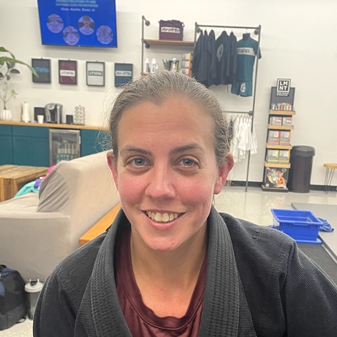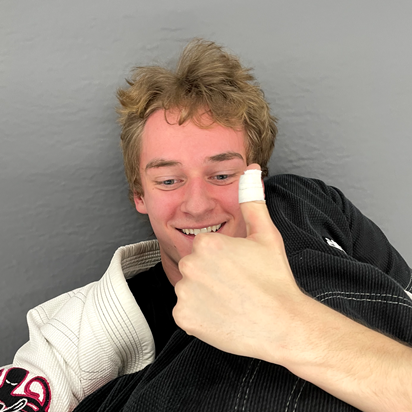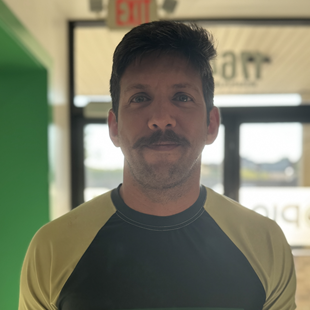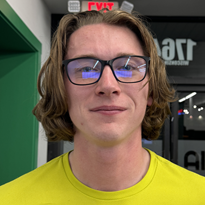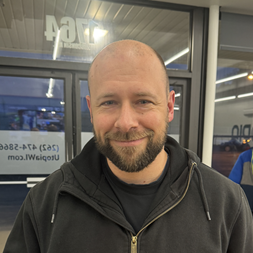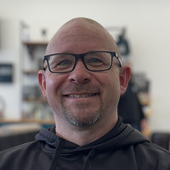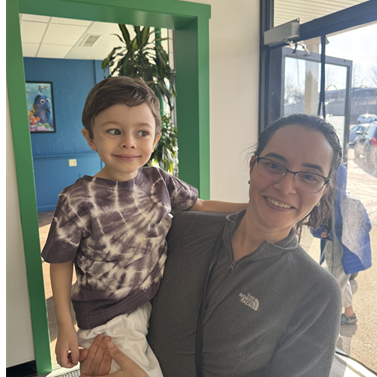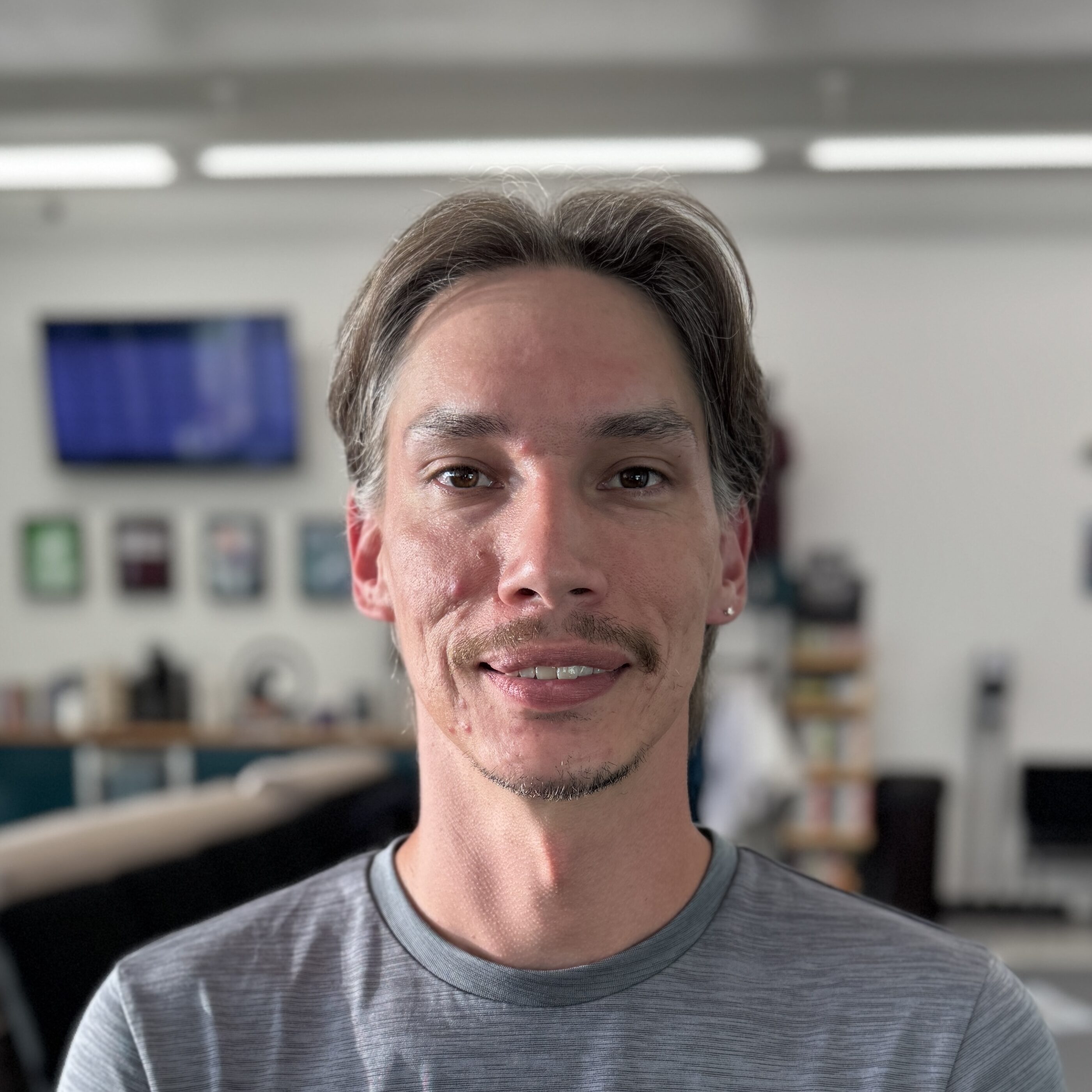In this latest episode of Inside the Wave, host Perry Wirth welcomes Dr. Joby Philip, a Brazilian Jiu-Jitsu practitioner, former wrestler, and Doctor of Physical Therapy. Dr. Joby, with his wealth of experience in physical therapy and a passion for grappling, offers invaluable insights into staying healthy, preventing injuries, and building longevity on the mats. The conversation dives into Dr. Joby’s journey from working in hospital settings to founding his own practice, Fortify Health and Performance. With practical tips and a holistic approach to health, this episode provides actionable advice for athletes looking to optimize their performance and recovery.
Key Takeaways
- Transitioning from Wrestling to Jiu-Jitsu: Dr. Joby shares how his wrestling background prepared him for the challenges and rewards of Brazilian Jiu-Jitsu.
- The Role of Strength Training in Injury Prevention: Discover how consistent strength work can cut injury risk by 50% or more.
- Managing Common Jiu-Jitsu Injuries: Practical advice on dealing with knee, shoulder, and elbow injuries, plus the importance of staying active during recovery.
- The Importance of Community and Mental Resilience: Dr. Joby explains how Jiu-Jitsu offers mental breaks and builds focus that other activities often lack.
- Starting a Business and Pursuing Passion: Hear about the challenges and rewards of running Fortify Health and Performance.
- Balancing Athletic Goals with Long-Term Health: Tips on embracing a “marathon mindset” to train smarter, not harder.
Standout Quotes
- “Strength training reduces injury risk more than anything else. It’s about making the body resilient, not just flexible.”
- “There’s always risk in physical activities. The bigger risk is being sedentary and facing long-term health issues.”
- “Jiu-Jitsu provides that mental escape-when you’re on the mats, you’re completely in the moment.”
Where to Listen
🎧 Stream Episode 8 Now:
Connect with Dr. Joby Philip and Fortify Health
- Instagram: @jobyphilip.dpt
- Website: fortifyhealthperformance.com
About Utopia
At Utopia, we believe in personal growth through martial arts. Our community supports individuals of all ages, helping them challenge themselves, build resilience, and thrive both on and off the mats. Each episode of Inside the Wave aligns with our values of discipline, mentorship, and community, offering stories that inspire growth in every listener.
Why This Episode Matters
This conversation with Dr. Joby Philip is essential for any athlete, especially Jiu-Jitsu practitioners looking to enhance their longevity. Injury prevention is not just about avoiding setbacks but also about building strength and resilience for the long run. Dr. Joby’s insights reflect Utopia’s mission to foster growth and community, making this episode a must-listen for those who want to stay on the mats-and thrive-for years to come.
Like what you heard? Subscribe to Inside the Wave, leave a review, and share this episode with your community. Let’s spread the message of health, growth, and longevity on the mats!
Transcript
Perry: Welcome to the next episode of the inside the wave podcast. I am with a. A new friend who I’ve met in the last few weeks, Joby Phillip, Dr. Joby Phillip. He is a Brazilian jujitsu practitioner, former wrestler and doctor of physical therapy. I got that right. Right. Dr. Physical therapy. That’s right. Yeah. Very cool. And you started your own practice. Uh, well, you didn’t start your own practice, but you’ve been practicing physical therapy since 2013. And in my journey of Brazilian Jiu Jitsu, I’ve had to see quite a few physical therapists for overcoming injuries, um, post-surgical stuff. So I think it’s really cool that we’re having you on the podcast today to talk all things body and Jiu Jitsu. How did you, uh, how’d you get started in physical therapy and martial arts and stuff like that?
Joby: Um, yeah, as far as physical therapy, I, um, like you mentioned, I wrestled in high school and had a few trips to the athletic training room. And so it got to know, uh, the athletic trainer pretty well. And I think that’s kind of what got my interest started in sports medicine. And so I started looking for athletic training programs specifically. And then, um, so I did that for my undergrad at Marquette and then went from that into physical therapy.
Perry: Do you typically see that as a path, like a physical therapist comes from an athletic training background or even like maybe a kinesiology background too?
Joby: Totally, yeah. That’s pretty common, both of those.
Perry: And I don’t know about you, but I also spend a lot of time in the athletic training room. It was kind of like the hangout for people before practice. Was that the same at your school too?
Joby: Not as much, I think, at our school. And I’m not sure why that is. I mean, we had a pretty small athletic training room.
Perry: Ours was super tiny and they always had to kick people out of it. But the guy was like the coolest, nicest guy and super knowledgeable on sports. I think everyone just kind of like gravitated to hanging out around him. Yeah. Yeah. Very cool. And when you started doing physical therapy, you, uh, you were working in like the hospital system, right?
Joby: That’s right. Yeah. So I started out in a couple of different hospital systems or I moved from moved through a couple of different hospital systems and I went into private practice and then started my own practice, which I then shut down actually during covid or when just before covid had hit and then went went back to another private practice and then Um, just finally got to the point where it was like, I don’t think I can do this anymore. So it’s either like, I’m gonna, I’m gonna either, um, start a practice again, or like I might need to look for a different way to use my physical therapy degree. And so, um, so I, I did end up obviously relaunching, uh, a business and then, uh, which is now Fortify, uh, health and performance. And so, yeah, I’ve been doing that since, uh, 2022. Cool. Um, so yeah, about a year and a half, I think at this point.
Perry: Nice. And it’s based in Walker’s point, right? You, you use space out of commotion gym, so you get access to a lot of their stuff that you’re going on to, but it’s really your own individual, individual thing. What’s your favorite part about having your own practice and essentially your own business, right? Cause a lot of people don’t think about that.
Joby: Yeah. I mean, I think, uh, I think for me, the favorite part is just being able to mold it and shape it, you know, exactly the way, um, that I want to and, and kind of feel like I don’t have any constraints or there’s no red tape in terms of, you know, insurance or just the way that kind of the organization or that, you know, the hospital kind of determines that we do things. And so. Um, being able to do things that I feel like are in the best interest of, you know, the patient and, um, and also being able to do things that are, I think a little bit more kind of. Innovative or cutting edge or finding different ways to kind of practice that, um, outside of kind of the traditional way of doing things.
Perry: I was going to ask you that. Um, you know, I, I know a lot of times when you’re potentially working. Within another system, you have to hear to their policies, what they think is the best method to recover from something. Um, and quite often, depending on where you are in the world, they can be, you know, anywhere from a couple months to a couple of years behind, whether it’s in physical knowledge or technology as well. Um, do you find yourself running into that a lot in the healthcare program? Or like you knew something really cool you could do, but you didn’t really feel like you could do it because you didn’t have the blessing of the organization.
Joby: Yeah, I mean, I think when it comes to healthcare, things are just changing so rapidly and we’re always just learning more about the human body and how it works and what kind of optimal recovery looks like. And so, you know, even the stuff that I learned in PT school quickly, you know, at the time I learned it was probably already some of it was, you know, outdated, obviously the basics and kind of the foundational knowledge still, still remains, but like in terms of treatment, some of that, you know, gets outdated, outdated pretty quickly. And I think, um, yeah, in practicing in some of those settings, it was just, you know, you’re, there’s kind of this pressure to just like fit in and do what everyone else is doing. So I think it was more of that, that I was feeling. Um, and, and, you know, some of the, some of the, like the hospital clinics and stuff like that don’t necessarily have some of the space and equipment and things to be able to do some of the, uh, some of the things that I can now do being in a gym setting.
Perry: Oh, nice, nice. And let’s talk, let’s talk personal, too, because we’re going to get into all those tips around building resilient body and how to recover and stuff like that. But I think you have a really cool, unique background, right? So you have a family, you got two kids, we’re just talking about that two and five, which is cool. So, you know, kids get hurt a lot. So I’m sure your physical therapy-ness and knowledge is going to pay off down the road with that. For one, it is incredible to see like how little kids bodies move. I always marvel at that. Like, yeah. And how, how resilient they are to mechanics that they have is great. Yeah. Um, but you’re also a Brazilian Jiu Jitsu practitioner.
Joby: Tell us a little bit about that. Yeah. So I started, uh, Jiu Jitsu about a year and a half ago now. Um, and yeah, I think having done wrestling in high school, I think, uh, I’d always kind of wanted to get back on the mats. I can actually remember, um, You know, senior season, my last match, uh, and realizing that like, this is, this is over. Like, I’m probably never going to wrestle again. Yeah.
Perry: Uh, like a conference or a regionals thing where like, you know, if you don’t win, you’re not making the next tournament.
Joby: Right. And you know, the, the, you know, I was just sitting there, like the emotions hit and I was sobbing and, um, and it’s cool now, I think for me to like realize that, like, it didn’t, it didn’t have to go away completely. And now I’ve. been able to find that, um, you know, outlet again in jujitsu. And so, um, so yeah, I think, I think for a long time I, I, I had been interested, but just never pulled the trigger on it. And I think some of that, you know, becoming an entrepreneur has given me more flexibility in my schedule to be able to do something like this. And so I think that’s maybe a big part of the reason why I started when I did.
Perry: Nice, nice. Yeah, sports are interesting, especially sports growing up through kids, right? Because a lot of sports are like up and out, right? Either you become better at it, and you can stay in it, right? You go to the college levels, you go to wrestling, the Olympic levels. There are old timer tournaments, but a lot of times those are like collegiate wrestler off season things. And if you’re a former high school wrestler, like it’s hard to hold yourself in a tournament like that. I think one cool thing about Jiu Jitsu is, is there’s such, there’s so many older people doing it that at every level, every experience, it remains competitive. That like, if I want to go to a wrestling tournament right now, I’d maybe do okay, but that’s also because I do jiu-jitsu. But if I took like 10 years off of wrestling and was like, oh, I’m going to try wrestling again, I’d probably just get smoked. And nor can my body handle it. I’d probably feel like I got hit by a truck. Very cool. What do you love about jiu-jitsu? What drew you to it with your knowledge of the body, your past experience with wrestling, everything in your life? Why jiu-jitsu? You’re just like, I fixed the body enough. I need more clients. I want to break some arms or.
Joby: Yeah. Well, I think again, just having the wrestling background, I think that, you know, the similarity there with, uh, being a grappling sport. So I think that was, uh, definitely part of it, but I think. what, what kind of got me hooked, I think too, is, um, is I quickly realized that like that hour of doing jujitsu, it’s like, I am fully immersed in it. And, um, you know, unlike lifting, which I, for a long time, I’ve just been lifting and I love it and I enjoy that, but it’s not the same in terms of, you Um, you know, when I’m lifting, I can still be thinking about work or still be thinking about what else is going on in my life. And in jujitsu, it’s kind of hard to do that when you’re worried about, you know, someone choking you out or breaking your arm. And, uh, so I think that aspect of it, just, um, you know, being able to be fully immersed in that and just kind of the, the mental break that that, uh, gives me, I think that, um, and I would say also just the competition element and the challenge of it. Um, and realizing how complex it is. I don’t think I had a appreciation for that or understanding of that before I started. And so I think that just gives you kind of this drive to keep improving. And so I think that’s the other thing that’s kind of gotten me hooked, uh, to it and wanting to keep, you know, progressing in it.
Perry: I love it. Cool, man. So let’s let’s talk jiu jitsu a little bit. What do you find as a jiu jitsu practitioner, as well as looking at jiu jitsu from a physical therapy standpoint, you knowing the body standpoint, we’ll say that, what do you what do you see as like the most common injuries in jiu jitsu? I know there’s maybe want to put these in like types of injuries, right? There’s like, you can injure muscles, you can injure joints, you can injure bones. Maybe there’s more. Uh, but, but what do you see as the most common, common areas, stuff like that?
Joby: Yeah, I think, um, what I’ve seen and I, I actually looked up, uh, kind of the statistics on this. So I think, um, you probably wouldn’t be surprised to hear that like knee, shoulder, elbow tend to be the most common, uh, places that people get injured in jujitsu. And, um, you know, some of that can be like in the knee, you know, you’ve got meniscus injuries, uh, ligament, torn them all. Okay. Um, ACL, um, ACL, MCL probably primarily. Um, and then yeah, on the shoulder labral stuff, rotator cuff, um, elbow again, ligament, or even sometimes fractures from, you know, arm bars and stuff like that. And so, uh, I think that those are the most common, but then you also just have a wide. distribution of other things. Right. Um, so rib injuries, neck stuff, um, fingers, yeah. Fingers, especially for people who, you know, train in McGee a lot. So yeah.
Perry: Yeah. Interesting. And I think there’s a, we’re saying a lot of injuries and I don’t want to scare people off because at least in my experience, very rarely do we ever have major injuries at my gym in the on what 17 years I’ve been doing it. I’ve seen a couple dislocated shoulders. I saw Nana first week that we were open. Someone broke someone else’s forearm from a bicep splicer. Okay, of course, you know, that’s like your your bone actually breaking, which is very unusual, right? Um, had that bicep splicer on and the person’s like, it doesn’t hurt. Well, it’s like, of course it doesn’t hurt because it’s not going to hurt because it’s your bone until it breaks. Right. Um, lesson learned. This was back in like 2008. Right. We’re just young and young and dumb, but you know, I. definitely don’t see a lot of a lot of major injuries, at least in my opinion, especially in the practice room, right? Because we usually try to stay fairly safe and tap well before that happens, right? But you definitely see it, you know, in the UFC when there’s You know, thousands to tens of thousands of dollars on the line that if you can not tap out for 10 more seconds, maybe you can win. Right. Regardless here, break my arm. If I, you break my arm and I can still last 10 more seconds. I win money. Right. Right. So I don’t know. Yeah. Might be worth it, especially if they’re paying for your insurance.
Joby: Yeah. And I think, you know, I think the other part of that conversation too, is, you know, there’s always going to be some element of risk involved when you’re doing any sort of physical activity. Um, but I think people don’t talk enough about like, what’s the risk of being sedentary, right. Or what’s the risk of, and we know clearly like, you know, an injury you can overcome typically, you know, relatively easily. Um, some of the, some of the conditions and comorbidities and things related to You know, lack of physical activity, those are much harder to overcome. Um, but that’s kind of seen as a problem. You know, I’ll deal with that later, right down in life. Yeah. So I think that’s part of it. But then also I think like. If you, if you let kind of fear of injury keep you from doing stuff, there’s just going to be a lot of fun things that you’re never going to try. And again, most things involve some element of risk. And even if you try to eliminate as much risk as possible, you can still get hurt doing the most basic things at home. And we hear people injure their back sneezing or picking up something like a box or a laundry basket off the floor. Yeah, you know, you’d you’d I think you’d rather want to be resilient and physically robust so that when those injuries do happen, you’re able to recover faster and you’re able to manage that better for sure. So that’s kind of my perspective on that.
Perry: And I know you’re coming off of a forearm injury from punching a bag. That’s right. Like not jiu jitsu. You know, my most of my major injuries like I tore my meniscus literally standing up after my teacher was done teaching a technique. Getting up on the mat to go to my spot where I’m going to practice the technique, I tore my meniscus in that process. I tore another meniscus doing bodyweight lunges one day. My pec tear, I tore doing bodyweight dips. It’s such a weird freak thing, how things happen, but I’ve yet to have a major injury, like surgical injury in jujitsu. Have I sprained like a toe or an ankle or a knee doing jujitsu? For sure. But nothing that’s ever taken me out like months. It’s always just been like either wife getting out of bed in the morning. I like, I slept funny. Or like just lifting. Yeah. No honesty. Yeah. Um, and let’s put the injuries into at least my layman of two buckets, right? You have acute injuries of, I go for an arm bar and I. Make you go from not injured to injured like that. Right. And then you have the chronic stuff, the stuff that like builds up over time. Like, Oh, I’m getting old. My, my back is creaky or my neck or my knees. Um, do you treat those differently as a physical therapist? Do you look at those differently? Um, which one’s more scary when you see it on someone like, Oh man.
Joby: Yeah, yeah, yeah. So, I mean, I think, you know, kind of the overarching goal is the same in both, right? You’re trying to, like, at least the way that I view it is, whether it’s acute or chronic, we’re trying to help this person rebuild the qualities and capacities that they need to be able to handle the demands of you know, their sport, right? In this case, jujitsu. So kind of knowing, uh, what are the positions that they need to get into? What are the forces that are going to be required? Um, you know, what are they going to be required to handle from a, from a force standpoint? And, um, and yeah, gradually building them up to that. Now, in an acute sense, you’ve got to protect that area for, for a little while. Right. And based on, We know that different tissues have different healing timeframes. And so knowing that, you know, like a bone, you might need to be in a cast for a bit. Right. And so you do have to protect things for a bit while trying to keep that person as active as possible in that process and then gradually exposing that affected area to movement and load and stress to help rebuild that back up, where in a chronic sense, there’s there’s typically less. kind of protection needed only because that person is probably in a protective state to begin with.
Perry: Right. And then hurting them for so long. Exactly. Yeah.
Joby: Yeah. And so they begin to, it’s common for people to, to learn how to kind of cope with that, where they begin to avoid certain exercises or movements, or maybe they start playing a different style, you know, of their game because of it. Um, and so in that case, it’s really more about, we’re trying to, you know, find a way for them to, um, reenter those movements or activities, uh, that, that cause their symptoms, cause their pain. And we want to gradually expose them to that and build them up, uh, with that. So I think, you know, in that sense, I think chronic injuries are harder to, to deal with just because, um, again, because of how long it’s been going on and kind of the learned behaviors that happen. Um, you know, from, from dealing with that as opposed to acute things generally tend to heal and recover pretty well on their own. And you’re just trying to aid kind of the body doing it’s, you know, it’s, it’s thing in terms of healing. So, um, yeah.
Perry: How, how important is it? Or so let’s start with this. What was the typical demographic of people that you see in your practice? Are we talking like athletes? Are we talking about specific sports, different modalities, all ages? What, what are your, what’s your typical type of clientele?
Joby: Yeah. I mean, I would say, uh, so I see a variety of different ages, mostly, I think, you know, 30 somethings would probably be kind of the average 20 year olds just so resilient. Yeah. Um, yeah. And, uh, sorry, what was the other part of that question?
Perry: Do you tend to find yourself seeing people from like mostly jujitsu people are mostly like super active lifters or combined? people that are like above average in that athletic area or the more of the common person, or I know a lot of physical therapists, like they end up niching out in like, uh, the older population or injury recovery, uh, you know, stuff like that, post-surgical stuff.
Joby: Yeah. Yeah. So I think I mostly see, um, Well, people that, you know, I would say to, to bucket them all together would be like people that are looking to, um, get back to a certain level of performance or get back to doing something that they love. Um, so I see, I see people who do jujitsu, but I also see, you know, lifters and CrossFitters and a lot of different athletes. Yeah. Yeah. And again, people that, you know, are not just looking to get out of pain, that’s kind of just step one, but are looking to really get back to their previous level, right. And get back to the top of their game in whatever they’re doing. Um, so, you know, athlete in the sense of like, not necessarily like, it’s not like I’m working with just pros or anything like that. But I think everyone’s an athlete, you know, who, who plays a sport in the sense that, um, we’re trying to get better and we’re trying to improve and perform at our best. And so that’s kind of the type of person that I work with.
Perry: One thing that I have, and I’m curious on your position on this, but as a physical therapy patient, I was about to say customer patients, probably a better word. Right. Um, Yeah. And, and this is just that as a healthcare patient, right. A lot of times you’ll go to the doctor with like, oh man, it hurt my shoulder. And they’re like, take six weeks off and you’re good to go. Right. Where they don’t, they don’t truly understand at all how to adapt and adopt and like, you know, Hey, I want to go back to Jiu Jitsu. Well, they don’t know what Jiu Jitsu is. Right. By any means. Right. Like I get shoulder surgery and he’s like, Oh, you’re a Jiu Jitsu athlete. What is, what’s Jiu Jitsu? I’m like, well, if you’re fixing my shoulder, I hope you fix it so I can do Jiu Jitsu again. Right. How important do you think it is? You know, when you’re dealing with an athlete, let’s pick, like, we’re going to try to pick a sport that you’ve never, have you ever worked with someone that does the hammer toss? I have not. Do you know what the hammer toss is? I don’t. But like, if you had a hammer toss athlete come in that says, Hey, I need to get back to peak physical conditioning. Like you would research that, right? Like, what is it? Cause I heard you talking about like mechanics and force production and stuff like that. Like you must have to be able to understand that. Right.
Joby: 100%. Yeah. So, uh, I think that’s really important is that you need to know kind of where they’re trying to get to, right. In order to get them there. Yeah. Um, cause otherwise, what are you aiming for? Right. And so, um, we kind of call that doing a needs analysis. Right. So, um, determining what are the, again, based on their sport and activity, what are, what are the qualities that they need to get back to doing that? And then you work backwards from that to, to build up those qualities. So. Um, yeah, for sure. That’s, that’s a big part of it. And if I’m working with someone who hasn’t, uh, who I don’t personally have experience with that sport, then I’m going on YouTube or I’m, you know, looking up research articles, um, to, to figure out kind of, again, to get an idea of what they need to be able to do.
Perry: perfect. And I’m sure you know, your best patient is the one that you don’t have to see that long. And then you never have to see them again. Right. So like, you get them, you do what needs to be done to get them feeling better. Right. And I think some people, you know, the paranoid people like healthcare systems out to get me. They tell me I need 18 weeks of physical therapy, but I feel like you get it done in eight, right? But like, you know, I feel like you not being in the system, you have a lot more control over that and doing what needs to be done to get people fixed. But what are some of the things that you like to do Um, so you never have to see people again, like the injury prevention stuff and let’s, let’s play it. Cause I’m sure there’s a ton of different stuff dependent on their sport and common injuries in that sport. Like if I was a, I was doing headfirst skeleton racing on ice is probably a little bit different than a jujitsu athlete. Right. So, um, you being a jujitsu athlete and working with a lot of them was, what are some of the best things that people can do for injury prevention in that sport?
Joby: Yeah. So, I mean, um, Like we have something that can reduce injury risk by 50% or more. And if I, you know, if I told you that like, Hey, you could, you could cut your risk of injury in half. You’d probably be like, tell me what that is. Right. And it’s, it’s simple. It’s strength training. Right. And so, um, research over and over again has shown that, um, strength training outperforms basically anything else in terms of being able to reduce injury risk. Um, more so than warming up more so than stretching. Um, and, and I think those things get a lot more attention, uh, for whatever reason, but, um, but strength training again, has, has been shown to by far, uh, have the most effect on reducing injuries. Um, Um, now I think it’s important to, to like, you have to be obviously smart about how you go about that. Um, and it’s gotta be intelligent. It’s gotta be designed well. It’s gotta take into account, um, you know, the, the stresses of your sport training and it’s gotta compliment that and not, you know, compete with that. Right. Um, so I think all of that is important to take into account, but, um, You know, consistently exposing your body to near maximal loads is what causes adaptation is what makes your body more resilient is what helps, you know, your, all of your tissues, right. Your muscle, tendon, bone, cartilage, all of that stuff becomes stronger, uh, when you load it. And so that’s why strength training, um, you know, seems to be, um, or, or not seems to be, but is the thing that, that reduces injury risk, um, the most.
Perry: And in the strength training toolbox, there’s a lot of different tools and ways to use the tools and look at the tools. You know, whether it’s like strength training can mean Olympic lifting to people. It can mean I do kettlebell. It can mean I do CrossFit. It can mean I go to the WAC and I hit the machines a couple times a week. What are your general guidelines? Because I feel like a lot of athletes, like if you grew up doing athletics, you kind of know what your strength training looks like. But, you know, we get a lot of people in jujitsu that start at 30 years old and they haven’t done anything since they were 18, right? So what is a good, you know, just kind of like a ballpark, an entry level strength training program? What would you recommend to someone outside of like, you should probably get a trainer to help you with this, but like some general guidelines?
Joby: Yeah. No, I think that’s a great question. I think, you know, I like to focus on just doing the basics in terms of push, pull, squat, hinge. Um, and then outside of that, uh, you know, again, depending on the sport, if we’re talking about jujitsu, I think this is where the needs analysis is helpful is that, um, you also probably want to do things that are a little bit faster, right? A little bit more explosive because you’re going to be exposed to that kind of stuff, uh, in the sport. So jumping, throwing med balls, um, stuff like that. And then if there’s specific areas that you need to work on, right, because you’ve had a history of tiny. Yeah, that or like if you’ve got, if you’ve got, yeah, exactly. Yeah. So if you’ve got, you know, injuries or just a history of, of, um, yeah, issues going on, then, then you probably want to address those areas specifically. Or if like, you know, if there’s a certain, uh, area that, um, Like as a need for your sport and your strength training, those movements that I mentioned don’t really address it. Like I can think of like for jujitsu, maybe the knack, right? Like maybe doing some, in addition to those things I mentioned doing some specific exercises for the knack might be a good idea. Um, just because that’s, you know, getting a lot of. Stress and abuse.
Perry: It’s mine. Definitely is. Yeah. I was laying on my back last night and we were doing like my own escapes. I was like, man, my head feels heavy today. But I think it’s because I actually have a little bit of joint pain going on back there from getting my gi pulled over the top of my head the other week. Things I’m used to by now. But they always keep popping up. That’s cool. Do you have a way? To like, if I were to come to you professionally, is there a way that you like actually assess this? Like, do you have a, a system to be like, yep. Perry’s quads are way under strength or his right shoulder mobility really needs some help because if he gets caught in a Kimura, that thing is going gone.
Joby: Yeah, for sure. Um, yeah, so, you know, it’s, it’s going through the kind of the, again, the qualities that I’m typically looking at are one range of motion, um, to strength. Uh, but there’s also, you know, different types of strength, right? So we can look at isometric strength.
Perry: Um, super important in jujitsu.
Joby: Yeah. Yeah. And specifically, you know, you can look at more isolated, right? So I can test just a shoulder into abduction, for example, and we use like a device, um, that measures your force output with that. So, um, doing some isolated strength testing, but then also some global, you know, testing in terms of what’s your squat, what’s your deadlift, right. Or, okay.
Perry: We’re using like a lot of muscles or body parts. Exactly. Yeah.
Joby: Yeah, so I think all of these different, and then like if we’re looking at explosive strength, maybe measuring someone’s jump height, right? And so knowing kind of, again, what are the qualities that that person needs, and then having an assessment for each of those qualities is kind of the process that Um, that I use. And then that kind of tells me where they’re at in regards to each of those qualities. And we know what we need to address, like what their strengths are and what, what their weaknesses are. Um, and their program is going to be tailored to specifically addressing and bringing up their weaknesses.
Perry: Yeah. So there’s a lot of people, you know, I’ve been in this bucket before, especially when I was a lot younger that I get injured. And I’m not going to say what I did, but what’s the number one thing that you see grapplers try to do mistakes that they make when trying to fix their own injuries?
Joby: Yeah. I mean, I think one is just ignoring it. Right. And just letting it, um, letting it go on for, for too long. I mean, sometimes if things pop up, I’m not saying that you need to go get it checked out immediately. Um, there’s going to be things that pop up from time to time and as long as they resolve, that’s okay. Um, but if it’s, if it’s been going on for a while, you probably don’t want to just let that go or ignore that or think that like, I’m just going to slap a brace on this thing and it’s going to be fine. Um, so I think, uh, I think that tends to be one mistake. I think the other is, you know, I’m just going to rest it for a day or two or a week or longer even, and then just jump right back into what I was doing before. And the problem with that is people end up getting into this cycle of, you know, they rest, they feel better. And then they go back, but because they haven’t really done anything to address the injury, their pain comes back and then they have to stop again and rest. And it just becomes that sort of cycle. And it’s frustrating for people. And it’s because, again, they need to take the time to really, you know, one, get it assessed and then address those injuries and build that area up that isn’t, again, isn’t able to handle the demand of training. And so, yeah, I think those are some of the most common ones that I see.
Perry: Nice. What about stretching? I feel like every time someone’s hurt and it’s not a specific, like, just like, Oh, I have knee pain. It’s like, Oh, my hamstring hurts. Everyone just jumps straight to stretching. Right. Right. It’s like, is that the right thing? Like, should you really be stretching all of the time? Like people do? Cause I personally, I never stretch. Yeah, but I have some good mobility. Yeah. Um, but it’s not like I go stretch before I lift or I’m go stretch before jiu jitsu class. Is that right? Or. Yeah.
Joby: I mean, I think, I think it depends again, like if you have, if you have a severe, you know, kind of mobility or range of motion restriction, it might be, you know, it might be a good thing to stretch, but it might not need to look like, you know, just passive stretching in terms of holding a stretch for 60 seconds. Right. It could be more dynamic in terms of movement and stuff like that.
Perry: Like swings. Right. Yeah.
Joby: Yeah. Um, or even lunges or something like that. I, you know, you could consider that, you know, mobility training, uh, as well. Right. But I think, um, you know, I think strength training oftentimes can take care a lot, take care of a lot of that in terms of developing, not just the flexibility that, that you’d be looking to get through stretching, but you’re also developing strength through those ranges of motion. Um, which in my mind, you know, is, is more functional, right? Not only do you want. flexibility, but you want to be strong in those different ranges of motion because otherwise, again, like if you get put into a Kimura or something like that, it’s great if you have the flexibility, but if you’re not strong there, it’s not helping you that much, right? So I think As long as you’re doing, um, as long as you’ve got kind of a good strength training program going on, I don’t think you need a ton outside of that. Um, you know, aside from some maybe very specific mobility things that you’re doing to address specific limitations you have. Nice.
Perry: And what is your, you know, let’s pretend I just got hurt. Right. What’s the best way to assess myself if it’s like, Hey, it’s something I can push through or it’s something I should take more seriously. I mean, obviously like if I hear a bunch of noise, I’m probably not going to like. Keep pushing through. Yeah. Yeah. Right. But like, how do I, how do I manage that? Like when’s the right time to go see someone when’s the right time to maybe just let it heal for a couple of days.
Joby: Yeah. So, I mean, I think there’s, there’s a few different factors that would probably weigh in on that sort of decision. So I think, you know, how long has this been going on for? Right. How severe is the pain? Is it more of just like a dull ache or is it more of a sharp shooting pain? Right.
Perry: So I think it’s one worse than the other. Yeah.
Joby: I mean, I would, I would take sharp shooting a little bit more seriously. Yeah. Okay. Um, Yeah. And then also, I think just looking at like, you know, are there, um, can you make sense of the injury in terms of like, um, you know, have you been doing more or recovering less? And does it make sense that you’d be kind of sore and achy or that you’d have some things pop up? And if so, maybe all you need is, you know, to, to prioritize recovery a bit more, right. Uh, or take a rest day or, or just go easy for a couple of days to let your body recover. Um, so if there’s things that, you know, you think like it might just be related to overtraining, right. You could address that. Um, but again, if, if you’ve tried some of those things and it’s still lingering on, I think it’s worth getting an assessment at that point to kind of figure out how you can address this. So it doesn’t become, you know, more of a chronic thing.
Perry: Now, what if you are fairly certain you might’ve like sprained, strained, something like that. Like someone hit a toehold on you and it sounded like celery cracking or like, you know, someone hits daily Hiva and your knee pops. Yeah. Right. Like at that point in time, you just kind of like, Hey, let’s see what it feels like in three days. And if it’s improving, let it be on its path.
Joby: Yeah. So, I mean, I think if it’s in those cases, like if it’s affecting like your ability to walk, right. Um, yeah. So if weight bearing is difficult, that sort of thing, that would also be another trigger. That’d be like, Hey, go get this checked out. Right. Which would probably be the case, uh, in either of those situations or, um, yeah, like if, if there’s a tenderness, like to the bone specifically, like if you’re pushing around the bone, that, that can be, um, you know, a reason to go get it checked out. Um, but also, I mean, if your gut just tells you like, I, I felt a pop, right. And it, and it didn’t feel good. Like, yeah, go get it checked out. Interesting.
Perry: So I’ve definitely had injuries in jujitsu where like my knee would pop and you know, sometimes it feels like good at first and you’re like, yeah, that kind of felt good. But then I’d wake up in the morning, forgot I hurt my knee, get out of bed. And I literally fall on my floor. Cause I was like, Oh wait, that does not feel good anymore. Cause I just, the second I put weight on, it’s like, Oh, not going anywhere. Um, so like that point in time, I should probably go make sure I didn’t tear my LCL or something.
Joby: And yeah, to your point, I mean, sometimes. Joints can pop and if it’s not painful, it’s often, you know, not something to be super concerned about. Um, but once it starts resulting in pain and, and, uh, starts affecting your function, then for sure.
Perry: Yeah. Cool. Um, so a lot of people that do. jujitsu at some point in time, arrive at the point where like, they want to do jujitsu forever. What’s your best piece of advice for them to do that? Right? Like balancing these like short term wins, like, Oh, I’m having a good job at jujitsu. I don’t want to stop doing it. Versus like, I want to do jujitsu forever. And even though we all know in our brains that, Hey, I should probably just rest or go see help. If you want, like, we also don’t want to take time off the mat. Right. Right. What would you say to convince someone that like, Hey, you need to listen to your brain and not your, uh, like what you really want to do. Yeah. Desires, right. Yeah. Versus the desires.
Joby: Yeah. I think, um, You know, I think if you want to do it for a long time, then you’ve just got to kind of embrace and adopt the mindset that it’s a marathon, it’s not a sprint. Um, and you know, it’s kind of the idea that like, if I told you I was going to run a marathon in a couple of weeks and you’re like, Oh, cool. Um, how long have you been training for that? And I’m like, I haven’t started yet. Right. You’d be like, you’re stupid. And, you know, it’s kind of the same thing. I think when we try to like force things to happen or when we try to force progress or focus on, you know, instantaneous results, and we kind of want that. Right. But realizing that, like, okay, if I’m looking to do this for a long time, I got to play the long game here. And, um, and that means taking it slow. That means, you know, listening to my body when things come up, I’m going to address it. I’m not going to ignore it. Um, you know, it means doing all the right things in terms of. Trying to, you know, trying to focus on recovery, trying to, you know, um, build that resilience that we talked about through strength training, doing all of those things I think is going to help you have the best shot of being able to do this for as long as possible.
Perry: Now what’s your routine as a physical therapist to keep yourself on the mat? I know you do some strength training, like are there specific things that you do on a regular basis, routines, habits, exercises, because your body needs them that help you stay at a high functioning level?
Joby: Yeah. So currently I strength train two times a week, uh, and I do jujitsu four times a week. So that’s kind of my, um, balance at this point. And that seems to be working pretty well. Um, so, uh, strength training again, I, I do basically what I outlined before, you know, push, pull, squat, hinge, and then, you know, abs, right. Working, working, um, you probably vary up like the weight.
Perry: So you do some heavier stuff, sometimes some explosive stuff. Right.
Joby: Exactly. Yeah. So, so I’m also including jumps, throws, sprints, uh, stuff like that to work on more of the explosive and, and, and, you know, the, the faster rate of force development. And then, um, for me, kind of the problem areas that I’m addressing are my neck, um, and, uh, and my low back. And so I, those tend to be the areas that I need to give a little bit more attention to.
Perry: And I’m right there with you and I know. Especially the neck is very complex because it moves like in all directions, right? Twist turns, there’s capital movement on it, up, down, left, right, like all the areas. What are some things that you do for injury prevention, specifically for your neck and for your lower back?
Joby: Yeah. So, um, one is, um, I find it personally beneficial to, uh, just have like a mobility routine. So, um, so I, yeah, exactly.
Perry: Yeah. I go through some cars. Explain what cars are. Cause I don’t, no one else probably knows what cars are.
Joby: So car stands for controlled articular rotations. Uh, and so basically you’re just taking your neck. Um, I mean, I can demonstrate right now.
Perry: If you’re listening, just go watch the video or Google car.
Joby: So you can just take your neck through the full. Range of motion. And you’re just going slow as you do that circular motion. Um, and the idea is you’re trying to kind of scrape the end range of motion. Um, almost like there’s,
Perry: That’s what I’m doing. I’m going to make you talk to me while I do this the entire time. But what do you do when there’s a sticking spot? I get to this back corner, it’s like, damn, that’s messed up.
Joby: Yeah. So if there’s a sticking spot, I, I, you know, I back off just slightly there.
Perry: Um, so keep it hammer through it.
Joby: Yeah. Keep it tolerable. But like that also becomes a good, um, you know, kind of indicator for you of like, okay, where’s my neck at today in terms of recovery. Right. And, you know, do I need to go a little bit easier?
Perry: So probably something I should do before I train, I lift my head off the ground. I’m like, man, my neck is sore today. I should probably see how sore it is before I get into a scenario where someone tries ripping it off.
Joby: Yeah. And I can kind of tell you how recovered you are. Right. And if you need maybe to go a little bit lighter or maybe, you know, maybe I, I go tomorrow instead of today, right. To give my neck an extra day, uh, to recover. So I think, um, I, I use that sometimes to gauge again, where I’m at and make some of those decisions, but I also find that it’s just helpful to, you know, to do that mobility work. And when I, when I don’t move it, it tends to stiffen up and tighten up more.
Perry: I find it like today, man, my legs are feeling great. And then I went down my stairs and like, well, they are, they are sore today. Like they weren’t sore walking around. The second I went downstairs, they were sore. Yeah. So it’s like, it’s a nice check-in with your body before you go like ham on it. Right.
Joby: Cool. Yeah. And that’s where I think, you know, a warmup routine can be helpful for that as well.
Perry: What about lower back? Cause I know that’s another one that, you know, tends to be common in a lot of people. Cause we do play in that, uh, that concave back position fairly often in jujitsu. I definitely have those like wrestler like wrestler back in general, like little hunched over like protecting my core all of the time.
Joby: Yeah. Yeah. Yeah. So, I mean, for me, I, um, you know, I’ll do again, some mobility stuff like cat cows as, as sort of a warmup, um, or just throughout the day, if I feel like I need to loosen up. Um, but then, but then I’ll do some specific exercises to try to target, you know, specifically my low back and strengthen that area. So, um, sometimes I’ll do, you know, like the reverse hyper machine, um, or I’ll do like a 45 degree back extension. Um, Yeah. So those two tend to be kind of my go-tos. I’ve started playing around with a little bit like doing like a seated good morning, um, either with a dumbbell or, uh, or with like a barbell and a Zurcher hold. Um, and that one is pretty taxing on the back. So I think I just, I, I’m trying to figure out kind of how exactly to, um, you know, to, to add that to the routine.
Perry: Do you like it seated? Cause it takes your hamstrings out of it then. Exactly. Exactly. Yeah. Okay.
Joby: So it isolates it more to the lower back area. And it just builds that tolerance to, I mean, because in jujitsu, again, you are in a flex position so much of the time. And so I think, I think, you know, theoretically it’s, it’s beneficial because you’re building tolerance to, to being in that position, right. And loading your spine in that position. Um, but again, it’s gotta be balanced with, you know, your training and, and how recovered you are and all of that stuff. So I don’t want someone to hear that and just think like, Oh, I’m going to, I’m going to go do heavy Zurcher good mornings and my back’s going to feel amazing. And that might not be the case. Right. So, um, so take that, take that into account.
Perry: Cool. Uh, I’m going to throw you on the spot on this one. Uh, a lot of, uh, in my opinion, a lot of Jiu Jitsu schools have super shit warmups, right? If you were a Jiu Jitsu coach leading a Jiu Jitsu class, meaning you can’t individualize the warmup or prep for a class by person, you have to do it for everyone. Is there a set of exercises and pretend you have every tool in the world? Let’s say you had like the iron neck. Let’s say you have 50 of them, right? Is there a set of exercises that you would say is great for the general population that like you would do before or after like every jujitsu class or once a day or something like that? Like what are the things that you see most common in our sports?
Joby: Yeah, that’s a good question. I think, um, I think the things that, well, I guess I’ll share kind of things that I do because I think they kind of fill the. the buckets that I feel like I need to address. But, um, you know, for me again, with, with having some of the neck issues, like I’ll usually, um, just do some inversions, right. And, uh, and just kind of get my neck used to being in that position, like barren Bolli kind of stuff or.
Perry: Like a baseball, I call it baseball structure. You lay on your feet, you’re laying on your feet, you lay on your back and you reach your feet over your head. Yeah.
Joby: Cool. Yeah. So just because for me, I feel like that’s helpful so that when I get stacked, that’s not the first time I’ve been in that position and I can kind of, you know, again, gradually expose myself to being there.
Perry: And I think that was important because even if you don’t play that, like inverted guard, you don’t also always get the choice of doing the jujitsu you want to do. Exactly. Someone’s probably going to stack you at some point in time, so better be ready and prepared for it.
Joby: Yeah. So, so that one, um, again, like cat cows or just some like rock backs for the low back. Um, I really liked doing like a, uh, Cossack squat or like a lateral lunge, uh, from side to side, just because I feel like that hits, you know, ankle, knees, hips, uh, for me. And so. Um, and then sometimes I’ll just do some like, um, you know, like pogo hops or just like bouncing around just, um, just to get like Achilles calves, uh, going, but that’s, you know, I keep it pretty simple, but those are kind of the movements that are, are my go-to. Um, but yeah, I don’t think there’s any one specific routine that like everyone needs to do. It probably needs to be individualized to, you know, kind of what you need to focus on.
Perry: Cool. Um, now it, what should a jujitsu person, you know, uh, what should a jujitsu person look for when they’re looking for a clinic, a practitioner, a physical therapist? Like, are there certain like degrees or certifications or questions you should ask them before you really get started? Or like, Hey, now that we all know needs analysis, like if they don’t do one, then we probably should go on to someone else.
Joby: Yeah. Yeah. So I, I think, uh, again, that needs analysis is important. So, you know, if they have, if they do the sport, that’s, you know, that’s a huge bonus, but even if they don’t, um, that they’re taking the time to like, listen and really understand what it is that you’re doing and what it is that you’re looking to get back to. And if they’re not asking you those types of questions, then, um, again, like you’ve got to ask yourself, how are they going to be able to help you get there? Right. And so. If they don’t do the sport, they need to be trying to learn about it somehow, and often that’s through you and asking you questions.
Perry: It’s a hard sport to know. It’s not just soccer or baseball or, you know, football that everyone has watched growing up in the NAIA. They can have an idea in their brain of like what’s required. Right. You know, most people you tell them jujitsu and they think you’re getting punched. It’s like, no, no, no. But people are trying to fold me in half and twist my spine. Right. And over rotate my arms.
Joby: Right. Yeah. So I think that’s big. And then I think, um, also just someone that, you know, can take the time to, um, to listen and, and really understand again, what your goals are. Um, because I think even just that, like as basic as that should be, like that isn’t kind of the standard of care. A lot of places just, um, you know, you have a physical therapist that’s seeing four or five people at once and very transactional. Yeah. And you just don’t get, um, I don’t think like the, you know, the time that you need for them to really understand and to individualize things for you. Um, so I think that’s, that’s a big one as well, that, uh, that you just feel like you’re getting the, you know, that one-on-one kind of attention and time with them. Nice.
Perry: Cool. Um, and I have to ask you, maybe you’re as psychopath as me, but like I look around in public and I’m always assessing like, okay, is something going to happen right now? Maybe it’s cause I’m just like paranoid, but like I’ll often notice like, man, that guy’s walking weird. Cause his ankles messed up. If shit goes down, I’m going to ankle lock them. Like, do you notice that because you’re in physical therapy that like, you just see people walking around and you see that they have like messed up gates or bad backs or elbows or whatever, like Should I like be hiding my injuries from you very consciously? Yeah.
Joby: I mean, I, I definitely tend to pick up on those types of things. Um, when it’s, when it’s more kind of obvious, you know, but I think, um, I also try not to like analyze too much. Um, cause, cause I mean, I also, I guess, believe that like variance is a good thing and, and people are different in the way that they move. And sometimes. Things that some people will say like, Oh, look how funny that person moves or like that’s going to be a problem for them. I, I don’t always think is the case, right? Like that just might be how that person is built and how they, how they function and move.
Perry: So I try not to read too much into some of those things that against them in jujitsu for sure. Yeah. Right. Like if you have that guy that, you know, his body is not made to be stacked and it’s going to be painful to stack. And I’m like, maybe I go for stack passes that match granted. Like, and we’re, I’m not talking training room, like with my friends and stuff like that. Like, but I’m like in a competition, I’m going to play that other person’s body styles. Limitations. Yeah. Yeah. Yeah, for sure. Do you think you have a huge advantage in like recognizing those over the average person? I feel like I do only because I’ve done jujitsu for so long. You actually truly understand the body.
Joby: Yeah, maybe. I don’t know if it’s maybe because… you know, I’m still fairly new. And so I think there’s just so much going through my head that you’re still worried about like doing the techniques.
Perry: Yeah, exactly. Yeah, you’re not you’re not pass.
Joby: I don’t know if I’m like, really able to think at that level.
Perry: But to think someday as as like, not that you do physical therapy passively, but you do been doing it for so long, you probably don’t have to think about it. like you did in your first two years of it. Think about having that and like that in a black belt jujitsu style level of shit. It’s terrifying. That’s terrifying. I feel like it’s kind of like the power lifter that turns jujitsu guy. Yeah. And eventually they learn a lot of jujitsu, but then they’re also still strong as shit. Right? Like if you’re just strong as shit and you don’t know jujitsu, that’s fine. If you have both of those, you’re a terrifying human being. Right. Like I just saw, um, Yeah. Do you know Jason Khalifa is he like CrossFit games? Like, I don’t know if he ever won, but he has a couple like top five for several years. He just did like a, a three way competition with Tim Kennedy, another Brazilian Jiu Jitsu, black belt, green beret, military guy. They, they competed in a workout. Okay. They competed in shooting and they competed in Jiu Jitsu. And I can’t remember what rank Jason Khalifa is now. Tim Kennedy’s a black belt, but like, man. That would be terrifying going against like even a purple belt that was also the world’s most fit man. Like, you’re not going to be stronger than him. You’re not going to have a better gas tank than them. You’re not going to have more power than them. It’s like, Taijutsu is not that much better.
Joby: Yeah, which that kind of proves the point. I mean, when people say like, you know, like, strength isn’t that important, or like, I don’t need to do conditioning outside of jujitsu. Like, yeah, if you really think that, like, wait until you, you know, go up against someone like that, and then try to say that strength doesn’t matter.
Perry: I am a firm believer that that saying only matters Is only true with a highly experienced person with a highly unexperienced person, maybe around the same weight. Yeah. Right. Cause like you can take highly experienced and you have 130 pound black belt. But if you take a 230 pound, like world’s strongest man that can still move, like that’s still gonna be hard for that 130 pound black ball. They can win. Don’t get me wrong. Right. But like strength matters, but definitely you see that at like, you know, there, there’s a reason why all those ADC C champs are just roided out a huge, right. Because strength does matter. And Jiu-Jitsu has evolved so much that it’s not just an activity or a hobby. It’s a true sport. And those athletes are truly trying to become athletic. Versus when we first started Jiu-Jitsu, there weren’t that many in-shape dudes in the room. There were just a bunch of 35-year-olds back in the day. That this is kind of what we did as a hobby, right? I’m like, dude, people are just athletic and it’s super cool. Yeah. Nice. Uh, before you jump into rapid fire questions, any, uh, any other things that you want to share?
Joby: No, I think let’s do the rapid fire questions.
Perry: Cool. We got 10 of them for you today. Maybe I’ll make up a, maybe I’ll make up a bonus one. Uh, I already have a bonus one. What’s your favorite submission in jujitsu?
Joby: So currently it’s the triangle, not because I’m good at it or because I get it a lot, but for the longest time, like I couldn’t figure it out and I feel like it started to click a little bit and I’ve gotten it a couple of times recently. So I think right now that’s the one that I’m looking for the most.
Perry: What do you think the most dangerous submission in jujitsu is? Not on my list. I’m throwing you off. What’s that? Not on my list.
Joby: Yeah, yeah, yeah. No, I, I mean, the first one that came to mind is, is the arm bar. Um, I probably, yeah. I don’t know if that is actually objectively the most dangerous, but that scares me the most.
Perry: A lot of people have jumped to heel hooks. What scares me the most is Kimuras. Kimuras definitely scare me personally the most. I don’t know if they’re the most dangerous. What’s one exercise every jujitsu practitioner should do to prevent injury?
Joby: Yeah. I mean, if, if I had to choose just one, um, I probably go with like a front foot elevated split squat. And reason being, I think there’s just a lot of good things happening in that movement. Like you’re getting, you know, you’re, you’re loading the knees through a full range of motion. You’re getting length through the hip flexor and quad in the back leg. Um, you’re working the hips, right? You’re getting your ab and your adductors involved in your posture throughout. Yeah. So, I mean, I think there’s just a lot of good things happening in that movement that I think. But again, if I had to pick just one, it’d be that one.
Perry: Very cool. Uh, what’s better at wrestling or jujitsu?
Joby: Um, do you mean like strictly the S the sport of wrestling or jujitsu or, or like the discipline in, cause I mean, jujitsu includes wrestling.
Perry: That’s true. Uh, the sport.
Joby: Okay. Um, I’m going to go with jujitsu because, um, I, I personally think, uh, I enjoy it more because of the fact that like, you still get to do all the things that you do in wrestling. Uh, maybe not all the things, but, um, but takedowns to me are, are the most fun part of wrestling. Uh, and so you still have that plus all of the other stuff that, um, jujitsu has. Cool.
Perry: Uh, what’s the most challenging part about starting your own PT practice?
Joby: Yeah, I think it’s, uh, just putting myself out there consistently. Um, and, and learning to deal with, you know, the failure and rejection and stuff that comes with that along the way. Um, but yeah, I, I, and I, I think that’s been, um, that’s been one thing about being an entrepreneur that I think, um, you know, I’ve grown a lot personally from that.
Perry: Yeah. Nice. What’s your top, uh, go-to recovery tip for a post jujitsu session?
Joby: Yeah. I mean, personally, I don’t do anything super flashy. I just, you know, try to have a good meal and get a good night’s rest. So yeah.
Perry: What does a good meal look like for you?
Joby: Um, so, I mean, I’m, I’m trying to get, you know, a good size portion of, uh, protein, uh, and then some vegetables, some carbs. Um, but yeah, just, you know, sticking to the basics.
Perry: Cool. Uh, what’s a common misconception about physical therapy?
Joby: Yeah, I think it’d be that like, it’s only for catastrophic injuries or like if you’ve had surgery. Um, and I think there’s a lot of people that, um, you know, just have nagging aches and pains that they’ve just kind of settled with, like, you know, I’m going to have to live with this. And I think, um, there’s a lot that we can do for, uh, for, for those sorts of things to resolve them or, or at least help you learn how to manage that better so that it doesn’t limit you from doing the things that you want. Uh, so I think that’d be the biggest one.
Perry: Cool. What’s your favorite body part to treat?
Joby: Yeah, I think I’d go with the knee and specifically ACL injuries. Um, just because I think they’re so involved and, you know, just to see someone go from basically nothing, right? Like you can’t do much when you come out of surgery to back to their sport. I think it’s just fun to be with someone throughout that process.
Perry: And that’s like at the, if you had a spectrum of knee injuries, that’s like the worst, right? I mean, it could be worse if you have other structures at the same time, but like of all the ligaments in the knee, ACL is like the gold one. That’s the worst. Yeah. Of smallest things is like my little meniscus there. Right. Right. Uh, what’s the most rewarding part about being a physical therapist?
Joby: Yeah, I think it’s. Helping someone, especially the person I think who’s been stuck in pain for a long time, and they’ve seen different specialists, they’ve been to other providers, and they just kind of feel stuck, and they can’t do the things that they want to be able to do, and helping them get to the other side of that is incredibly rewarding, and it’s the reason why I love what I do.
Perry: Nice. If you could change one thing about the healthcare system that you used to be in, what would it be?
Joby: I think I would say just humanize health care more, meaning, you know, again, being able to be more, you know, relational and less transactional and and giving people actual solutions to things instead of telling them like, hey, you just need to stop or, you know, or kind of giving them kind of bandaid treatments. Yeah. So so I think it’s I think it’s cool.
Perry: What would, uh, what’s advice you would give to someone who’s looking to start jujitsu later in life?
Joby: Yeah, I think, um, don’t let your age be an excuse. Um. You can blame your age for why you can’t do certain things or why you feel a certain way, or you can do something about it and you can just start and start small and focus on consistent, slow progress. And if you feel like there’s certain things that are preventing you from starting, you know, maybe injuries, or maybe you feel like you just are so out of shape that you can’t do that, then you can address those things as well. Um, and, and, you know, you know, uh, seek out a professional help with that if you need to. But, um, but yeah, I would say you just have to start.
Perry: Nice. And I’m going to add some that you said earlier. Um, but a lot of people looking to start Jiu Jitsu means that they’re not doing anything else. And in the long run, it’s going to be a lot safer doing Jiu Jitsu than being sedentary. Right. Very cool. How can people get ahold of you? If they’re interested, they, you know, they got an egging injury, they’re hurt. They’re just having surgery. What’s the best way to get ahold of you? Where can they find you? How do they follow you?
Joby: Yeah, so you can follow me on Instagram. It’s jobeyphilip.dpt. Or you can go to my website. It’s fortifyhealthperformance.com.
Perry: Perfect. And we’ll put both those in the show notes as well as all of our little Instagram captions, man. Well, anything else to share? Any final last words?
Joby: I think that’s it. I think we covered a lot. Um, and I appreciate you having me on.
Perry: Yeah, man. It was great having you. Uh, don’t forget to follow this podcast, leave it, uh, all of the stars of reviewed and share it with your friends. I appreciate you guys. And thank you again for coming on the show.






















